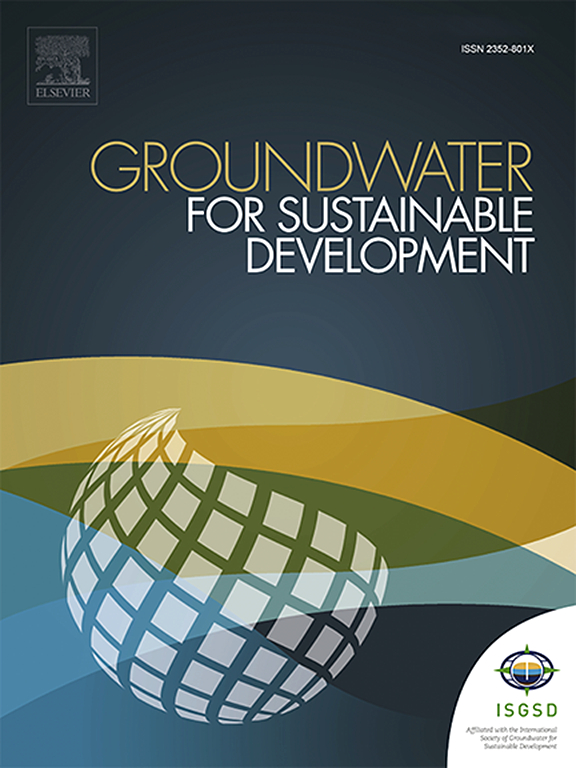Enhancing groundwater quality in a saline coastal aquifer through managed aquifer recharge: A comprehensive study by long-term groundwater level and hydrochemical monitoring
IF 4.9
Q2 ENGINEERING, ENVIRONMENTAL
引用次数: 0
Abstract
Safe drinking water has become scarce in many parts of the world, especially along the coast. Despite adequate rainfall in many coastal regions, over-exploitation has led to the threat of seawater intrusion. Induced recharge enhances groundwater storage and can mitigate seawater intrusion, especially in coastal areas with over-exploited freshwater resources. This study investigates the hydrogeochemical processes due to induced recharge by managed aquifer recharge (MAR) structure and its impact on improving groundwater quality in a saline coastal aquifer. As part of this study, an extensive analysis of hydrogeochemical processes was conducted within a combined MAR structure featuring a percolation pond and recharge shaft, along with the nearby observation piezometers from 2012 to 2019. Over 300 water samples from the MAR structure and the piezometers were analysed to assess the enhancement in groundwater storage and quality in the nearby area. The electrical conductivity of groundwater was reduced from 1801 to 149 μS/cm in the MAR structure and from 2627 to 183, 41,212 to 9127 and 70, 345 to 2933 μS/cm, respectively, in the piezometers P1, P2 and P3 drilled up to different depths. The major hydrogeochemical facies in MAR structure and piezometers are Na+-Cl- and Ca2+-Cl- types, indicating the influence of seawater mixing and base exchange of Na+ and Ca2+ ions. The principal component analysis identified three significant components in pond and piezometers, contributing to a corresponding total variance of 90.85 % and 97.82 % with higher factor loadings for Na+, Cl−, and K+. Considering the benefits and the economic feasibility of these MAR structures, they are strongly recommended in other regions with sufficient rainfall and salinity-related challenges.

通过有管理的含水层补给提高咸水海岸含水层的地下水质量:长期地下水位和水化学监测的综合研究
在世界上许多地方,特别是沿海地区,安全饮用水已经变得稀缺。尽管许多沿海地区降雨充足,但过度开发已导致海水入侵的威胁。诱导补给增加了地下水储量,可以减轻海水入侵,特别是在淡水资源过度开发的沿海地区。研究了滨海咸水含水层管理补给(MAR)结构诱导补给的水文地球化学过程及其对改善咸水含水层水质的影响。作为本研究的一部分,在2012年至2019年期间,在具有渗流池和补给井的组合MAR结构内以及附近的观测压电计内进行了广泛的水文地球化学过程分析。我们分析了从MAR结构和气压计取得的300多个水样,以评估附近地区地下水储存和水质的改善。在MAR结构中,地下水电导率从1801 μS/cm降至149 μS/cm;在不同深度的P1、P2和P3压计中,地下水电导率分别从2627 μS/cm降至183、41212至9127和70、345至2933 μS/cm。MAR结构和气压计的水文地球化学相主要为Na+- cl -型和Ca2+- cl -型,表明海水混合和Na+、Ca2+离子的碱交换的影响。主成分分析确定了池塘和气压计中3个显著成分,对相应的总方差贡献为90.85%和97.82%,其中Na+、Cl−和K+的因子负荷较高。考虑到这些MAR结构的效益和经济可行性,强烈建议在降雨充足和与盐碱度有关的挑战的其他地区采用这些结构。
本文章由计算机程序翻译,如有差异,请以英文原文为准。
求助全文
约1分钟内获得全文
求助全文
来源期刊

Groundwater for Sustainable Development
Social Sciences-Geography, Planning and Development
CiteScore
11.50
自引率
10.20%
发文量
152
期刊介绍:
Groundwater for Sustainable Development is directed to different stakeholders and professionals, including government and non-governmental organizations, international funding agencies, universities, public water institutions, public health and other public/private sector professionals, and other relevant institutions. It is aimed at professionals, academics and students in the fields of disciplines such as: groundwater and its connection to surface hydrology and environment, soil sciences, engineering, ecology, microbiology, atmospheric sciences, analytical chemistry, hydro-engineering, water technology, environmental ethics, economics, public health, policy, as well as social sciences, legal disciplines, or any other area connected with water issues. The objectives of this journal are to facilitate: • The improvement of effective and sustainable management of water resources across the globe. • The improvement of human access to groundwater resources in adequate quantity and good quality. • The meeting of the increasing demand for drinking and irrigation water needed for food security to contribute to a social and economically sound human development. • The creation of a global inter- and multidisciplinary platform and forum to improve our understanding of groundwater resources and to advocate their effective and sustainable management and protection against contamination. • Interdisciplinary information exchange and to stimulate scientific research in the fields of groundwater related sciences and social and health sciences required to achieve the United Nations Millennium Development Goals for sustainable development.
 求助内容:
求助内容: 应助结果提醒方式:
应助结果提醒方式:


